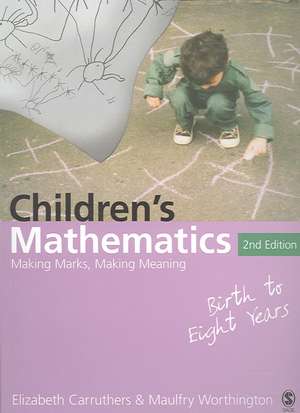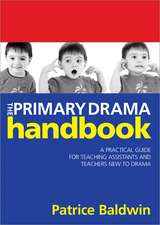Children's Mathematics: Making Marks, Making Meaning
Autor Elizabeth Carruthers, Maulfry Worthingtonen Limba Engleză Paperback – 7 aug 2006
'The review also plays great score by play-based learning of a mathematical nature, and makes specific recommendations regarding early mark-making as a precursor to abstract mathematical symbolism'. Section 115 features children's mathematical graphics and emphasises: 'The role of mark-making in children's cognitive development is set out in the taxonomy (Carruthers and Worthington, 2006)'. The report recommends that 'local authorities, leaders, managers and head teachers should provide a culture with a significant focus on mathematical mark-making' and 'a learning environment that encourages children to choose to use their own mathematical graphics to support their mathematical thinking and processes' - The Williams Maths Review: (DCSF, 2008)
`At the very heart of the success of the book is the authors' ability to see mathematics through young children's eyes by listening to and reflecting on the constant efforts made by children to make sense of their world. This is a liberating book which proposes that the teaching of mathematics could and should be a highly creative and enjoyable proceess' - Branwen Llewelyn Jones, Early Years Consultant at PACE Ltd / TACTYC
'Ground breaking... To single out any one chapter would be unfair because there is something thought-provoking and inspirational throughout. If you want to expand your understanding upwards and outwards then get a copy soon' - Times Educational Supplement
'I first read Children's Mathematics, Making Marks, Making Meaning a couple of years ago and it had an immediate impact on my own thinking and teaching, and the work I do with trainee teachers. I'm sure you will find it compelling reading too. I think it has the potential to change, in a fundamental way, how we think about early mathematical development' - Lynne McClure, Editor, Math Co-ordiator's File, Mathematics Association
'In their exceptionally readable and informative book, Children's Mathematics, Making Marks, Making Meaning Carruthers and Worthington (2006) draw attention to one of the main goals of early years teaching, that is, to help children make links between the mathematics they have already encountered (and continue to engage with) at home and the more abstract mathematics of the school. These authors suggest that by encouraging children to represent mathematical ideas in their own ways and, crucially, by talking to the pupils about the marks they have made, we are given a "window" onto their thinking that may otherwise be inaccessible' - Liz Pumphrey, NRICH
This book draws on the authors' many years of teaching children aged three to eight years and also on their extensive research with children in the home, nursery and school. The authors explain the development and range of young children's mathematical marks and visual representations, showing how children make mental connections between their own early marks and subsequent abstract mathematical symbolism, and go on to develop their own written methods.
Combining theory and practice, this acclaimed book demonstrates how children's own mathematical graphics are highly creative and show deep levels of thinking. The authors show how this is the key to success in school mathematics and to higher levels of achievement.
The authors are winners of TACTYC's (2003) Jenefer Joseph Award for the Creative Arts (3 - 8) - awarded for their innovative work with children on mathematical graphics.
Preț: 437.40 lei
Nou
Puncte Express: 656
Preț estimativ în valută:
83.69€ • 87.62$ • 69.25£
83.69€ • 87.62$ • 69.25£
Carte tipărită la comandă
Livrare economică 07-21 aprilie
Preluare comenzi: 021 569.72.76
Specificații
ISBN-13: 9781412922838
ISBN-10: 1412922836
Pagini: 280
Ilustrații: Illustrations
Dimensiuni: 170 x 242 x 16 mm
Greutate: 0.48 kg
Ediția:Second Edition
Editura: SAGE Publications
Colecția Sage Publications Ltd
Locul publicării:London, United Kingdom
ISBN-10: 1412922836
Pagini: 280
Ilustrații: Illustrations
Dimensiuni: 170 x 242 x 16 mm
Greutate: 0.48 kg
Ediția:Second Edition
Editura: SAGE Publications
Colecția Sage Publications Ltd
Locul publicării:London, United Kingdom
Recenzii
' I purchased a copy of your book over the holidays-it is my bebtime reading at the moment but it is far too stimulating'- Philippa Cook, Nursery Teacher, Clifton High School, Bristol
'Children's Mathematics: Making Marks, Making Meaning is essential reading for students of Education and Early Childhood Studies, as well as for those practitioners working in the Foundation and Primary stages of education' - Anne Cooper, Mathematics Association
'Thought-provoking and inspirational throughout. If you want to expand your understanding upwards and outwards then get a copy soon' - John Dabell, Education Consultant, Former Numeracy Consultant & Ofsted Inspector
Praise for the First Edition:
'Children's Mathematics: Making Marks, Making Meaning is essential reading for students of Education and Early Childhood Studies, as well as for those practitioners working in the Foundation and Primary stages of education' - Anne Cooper, Mathematics Association
'The writers make a very convincing case for the usefulness of exploring children's marks in order to understand their mathematical cognition. The examples of children's written representations provide fascinating insights into how different children think about mathematics' - Katherine Canobi, University of Melbourne
'Children's Mathematics: Making Marks, Making Meaning is essential reading for students of Education and Early Childhood Studies, as well as for those practitioners working in the Foundation and Primary stages of education' - Anne Cooper, Mathematics Association
'Thought-provoking and inspirational throughout. If you want to expand your understanding upwards and outwards then get a copy soon' - John Dabell, Education Consultant, Former Numeracy Consultant & Ofsted Inspector
Praise for the First Edition:
'Children's Mathematics: Making Marks, Making Meaning is essential reading for students of Education and Early Childhood Studies, as well as for those practitioners working in the Foundation and Primary stages of education' - Anne Cooper, Mathematics Association
'The writers make a very convincing case for the usefulness of exploring children's marks in order to understand their mathematical cognition. The examples of children's written representations provide fascinating insights into how different children think about mathematics' - Katherine Canobi, University of Melbourne
Cuprins
Who Takes Notice of Children's Own 'Written' Mathematics?
Children's Mathematical Graphics
International Findings
Studies That Relate To Mathematical Literacy
Enquiring into Children's Mathematics
Making Marks, Making Meaning
Children Making Meaning with Marks
Different Literacies: Mathematical Literacy
Children Represent Their Mathematical Actions and Understanding On Paper
Learning Theories
Reading and Using Mathematical Graphics
Sociocultural Perspectives Contexts in Early Years Settings
Teachers' Beliefs
Creativity in Mathematics
Summary
Mathematical Schemas
What Is a Schema?
Schemas and Mathematics
Schemas and Mark-Making
Observing Schemas in a School Setting
Mapping Patterns of Schema Exploration
Early Writing, Early Mathematics
The Significance of Emergent Writing
Young Children Explore Symbols
Early Writing and Early Mathematical Marks
Early (Emergent) Literacy Is Often Misunderstood
Conclusion
Bridging the Gap between Home and School Mathematics
Disconnections
Understanding Symbols
Mathematics as a Foreign Language
Becoming Binumerate
Teachers' Difficulties
Conclusion
Making Sense of Children's Mathematical Graphics
The Evolution of Children's Early Marks
Categories of Children's Mathematical Graphics
Common Forms of Graphical Marks
Early Development of Mathematical Meaning
Early Explorations with Marks
'The Beginning Is Everything'
Early Written Numerals
Numerals as Labels
Representations of Quantities and Counting
The Development of Early Written Number, Quantities and Counting
Understanding Children's Developing Calculations
Practical Mathematics
The Fifth Dimension: Written Calculations
Representations of Early Operations
Counting Continuously
Narrative Actions
Supporting Children's Own Mathematical Marks
Separating Sets
Exploring Symbols
Standard Symbolic Calculations with Small Numbers
Calculations with Larger Numbers Supported By Jottings
The Development of Children's Mathematical Graphics: Becoming Binumerate
Conclusion
Environments That Support Children's Mathematical Graphics
Rich Mathematical Environments for Learning
The Balance between Adult-Led and Child-Initiated Learning
Role-Play and Mark-Making
The Physical Environment
Practical Steps
Graphics Areas
Conclusion
Case Studies from Early Childhood Settings
The Birthday Cards
A Number Line
'No Entry'
Carl's Garage
Children's Centres: The Cambridge Learning Network Project
Spontaneous Dice Game
Young Children Think Division
A Zoo Visit
Mathematics and Literacy in Role-Play: The Library Van
Aaron and the Train
Multiplying Larger Numbers
Nectarines for a Picnic
Conclusion
Developing Children's Written Methods
The Assessment of Children's Mathematical Representations On Paper
The Problem with Worksheets
Assessing Samples of Children's Own Mathematics
Examples of Assessment of Children's Mathematics
The Pedagogy of Children's Mathematical Graphics
Modelling Mathematics
Involving Parents and Families
Children's First and Continuing Educators
The Home As a Rich Learning Environment
What Mathematics Do Young Children Do At Home?
What Mathematics Do Parents Notice At Home?
Parents Observe a Wealth of Mathematics
Helping Parents Recognise Children's Mathematical Marks
Parents' Questions about Children's Mathematical Graphics
Conclusion
Children, Teachers and Possibilities
Inclusion
Children's Questions
Teachers' Questions
It's All Very Well - But What About Test Scores?
Reflections
Children's Mathematical Graphics
International Findings
Studies That Relate To Mathematical Literacy
Enquiring into Children's Mathematics
Making Marks, Making Meaning
Children Making Meaning with Marks
Different Literacies: Mathematical Literacy
Children Represent Their Mathematical Actions and Understanding On Paper
Learning Theories
Reading and Using Mathematical Graphics
Sociocultural Perspectives Contexts in Early Years Settings
Teachers' Beliefs
Creativity in Mathematics
Summary
Mathematical Schemas
What Is a Schema?
Schemas and Mathematics
Schemas and Mark-Making
Observing Schemas in a School Setting
Mapping Patterns of Schema Exploration
Early Writing, Early Mathematics
The Significance of Emergent Writing
Young Children Explore Symbols
Early Writing and Early Mathematical Marks
Early (Emergent) Literacy Is Often Misunderstood
Conclusion
Bridging the Gap between Home and School Mathematics
Disconnections
Understanding Symbols
Mathematics as a Foreign Language
Becoming Binumerate
Teachers' Difficulties
Conclusion
Making Sense of Children's Mathematical Graphics
The Evolution of Children's Early Marks
Categories of Children's Mathematical Graphics
Common Forms of Graphical Marks
Early Development of Mathematical Meaning
Early Explorations with Marks
'The Beginning Is Everything'
Early Written Numerals
Numerals as Labels
Representations of Quantities and Counting
The Development of Early Written Number, Quantities and Counting
Understanding Children's Developing Calculations
Practical Mathematics
The Fifth Dimension: Written Calculations
Representations of Early Operations
Counting Continuously
Narrative Actions
Supporting Children's Own Mathematical Marks
Separating Sets
Exploring Symbols
Standard Symbolic Calculations with Small Numbers
Calculations with Larger Numbers Supported By Jottings
The Development of Children's Mathematical Graphics: Becoming Binumerate
Conclusion
Environments That Support Children's Mathematical Graphics
Rich Mathematical Environments for Learning
The Balance between Adult-Led and Child-Initiated Learning
Role-Play and Mark-Making
The Physical Environment
Practical Steps
Graphics Areas
Conclusion
Case Studies from Early Childhood Settings
The Birthday Cards
A Number Line
'No Entry'
Carl's Garage
Children's Centres: The Cambridge Learning Network Project
Spontaneous Dice Game
Young Children Think Division
A Zoo Visit
Mathematics and Literacy in Role-Play: The Library Van
Aaron and the Train
Multiplying Larger Numbers
Nectarines for a Picnic
Conclusion
Developing Children's Written Methods
The Assessment of Children's Mathematical Representations On Paper
The Problem with Worksheets
Assessing Samples of Children's Own Mathematics
Examples of Assessment of Children's Mathematics
The Pedagogy of Children's Mathematical Graphics
Modelling Mathematics
Involving Parents and Families
Children's First and Continuing Educators
The Home As a Rich Learning Environment
What Mathematics Do Young Children Do At Home?
What Mathematics Do Parents Notice At Home?
Parents Observe a Wealth of Mathematics
Helping Parents Recognise Children's Mathematical Marks
Parents' Questions about Children's Mathematical Graphics
Conclusion
Children, Teachers and Possibilities
Inclusion
Children's Questions
Teachers' Questions
It's All Very Well - But What About Test Scores?
Reflections
Descriere
This resource demonstrates how children's mathematical graphics reflect deep levels of thinking, and identifies this as the key to success in mathematics and higher achievement levels.






